For readers who would have liked to attend the 2017 Vectorworks Design Summit but could not make it, the company this year had live video streaming of the two keynote talks. Those streams are still available on the company’s Facebook here. If you have an hour be sure to watch Brad Cloepfil’s Design Keynote, his firm Allied Works Architecture is an award-winning firm doing stunning projects around the world.
If you don’t have an hour, we have a short summary of his main points in his talk. Also in this article is an annotated gallery of images from the entire event.
Design Keynote Highlights
Brad Cloepfil began his talk by putting up the following quote:
“The process of drawing is, before all else, the process of putting visual intelligence into action, the very mechanics of visual thought. It is a soliloquy before it becomes communication.” — Michael Ayrton
It was an appropriate quote that set the tone for an engaging presentation of the work of Allied Works Architecture.
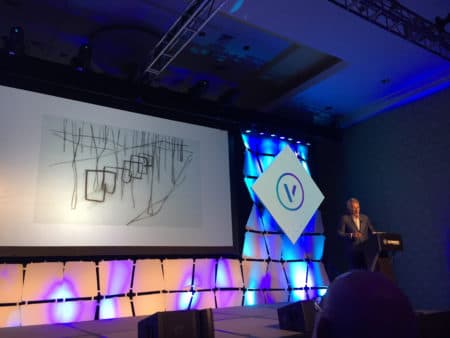
01 – Brad Cloepfil, Principal of Allied Works Architecture speaking at the 2017 Vectorworks Design Summit about the importance of drawing as part of the creative process.
Cloepfil noted that artist Richard Serra is his great inspiration, stating “he draws in steel” while yet other inspiring artists of his draw in light. A self-described Oregon suburban kid, he was first educated at Pratt then back to the University of Oregon and then back to New York City for his graduate degree. Post architecture school, Cloepfil worked at stints at celebrated architecture firms like SOM, and in Europe for Mario Botta and was heavily influenced by professors at U of O who were former Kahn associates who moved there to teach after Kahn’s death.
Cloepfil spoke of both the process of drawing and making things by hand. Drawings are so important to him that he told the story of how Vectorworks—then MiniCAD—came into his office only after his younger staff convinced him MiniCAD could make beautiful drawings that replicate the qualities of hand drawings while still be accurate and technical.
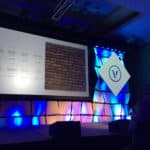
02 – A side-by-side image of a Vectorworks-based drawing showing the custom formwork forms needed for the concrete results shown at right.
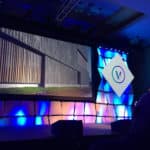
03 – A view of the finished concrete work based on the unique custom forms Allied Works helped create.

04 – An inside view of the Clyfford Still Museum. The previous two images are of the exterior of this project.
Cloepfil presented several noted projects, including the Clyfford Still Museum in Denver. A small institution devoted to a single artist, the project was made of cast-in-place concrete exterior and interior walls, with the exterior walls having a truly unique quality and texture. In the image above (see 02) Cloepfil explains how the firm developed individually unique formwork. Also innovative in this project was the highly developed way in which light enters the gallery spaces via a complex mesh-like screening that forms the ceiling barrier. (see image 04).
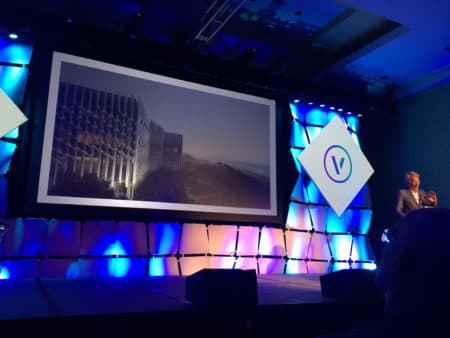
05 – This US Embassy project has a stunning brise-soleil design that ARUP helped engineer to prevent direct sun at any time of the year, while still letting in light and some views.
The intensity of interest in light in architecture is omnipresent throughout Allied Works Architecture’s deep portfolio of completed projects. Cloepfil also spoke about his firm’s US embassy project in Mozambique. Meeting new US State Department security requirements, the large-scale project has a remarkable facade brise-soleil that controls both light and views while meeting new security standards.
Allied Works Architecture, as Architosh has written in the past, spans multiple building types and scales, from private residences to large performance art centers and government buildings. Architosh will have more to say about Brad Cloepfil in the near future.
Gallery From Summit
What follows below are some photos from Architosh from the days at the 2017 Vectorworks Design Summit.
For the three years the Vectorworks folks have run this event annually, the day before the event, or registration day, is typically a partial hands-on training day. This year these types of sessions were included in the normal two-day sessions.
Day zero, or registration day, started with a cocktail networking event that included light food. Various attendees who generally come every year may have broke-off to dinner after and some attended a pro baseball game at Camden Yards, which was literally walkable from the hotel. (see image 06)
In the previous past two years, the Vectorworks Design Summit was led by a CEO keynote that included an advanced view of what was coming in the next major Vectorworks software release. This year, the company held the event a week after the major release was announced. Still, part of the CEO’s keynote did include a peek at technologies the company is working on for possible future software.
My thought on this “adjustment” from past events is that perhaps that early view was maybe a reason why attendees partly came to the event, but likely it ranks lower than the importance of training sessions, networking, and direct contact with the software company to discuss how it is meeting or not meeting the needs of various firms. Seeing the advanced forward-view of tech that the company is working on without any promises is also very nice, and at least one of the technologies previewed during the keynote got a “wow” from the audience.
As can be seen in the image below, the keynote hall was narrow and deep, clearly a limitation of the Marriott’s conferencing options at this particular hotel rather than a preference from Vectorworks. (see image 07)
This year it seemed there were more press invites than any prior year that I recall and a “press-only” briefing event took place prior to the actual keynote. That event was actually recorded and can be seen here. In the image below, Dan Monaghan, VP of Marketing Vectorworks (at left) talks about improved graphical scripting features in the latest Marionette technology inside Vectorworks 2018. (see 08).
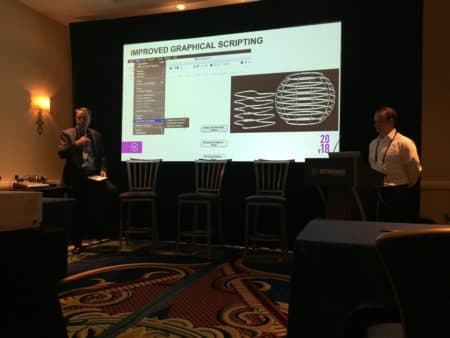
08 – The Press had their own presentation of Vectorworks 2018 given to them with a Q&A session following.
And speaking of Marionette, Jean Dières Monplaisir and Daniel Irvine presented one of the best sessions I’ve attended at any event, AIA National included, titled, “Between Design Iteration and Physical Construction, Marionette as a Platform-Bridging Process.”
Architosh will hopefully have a complete feature on their talk and their work, but in a snapshot, they both convincingly demonstrated a complete practical application of the use of Marionette in a real architectural project from end-to-end. Moreover, the project’s aesthetic qualities were exceptional and deeply connected to the process of designing with algorithmic tools.
What was particularly excellent about this session was the depth covered and the degree to which the attendee could understand the specific purposes for why algorithmic tools like Marionette are utilized and why not utilizing them would have made this project so much more difficult if not impossible under the time-constraints the project lived under. (see image 09).
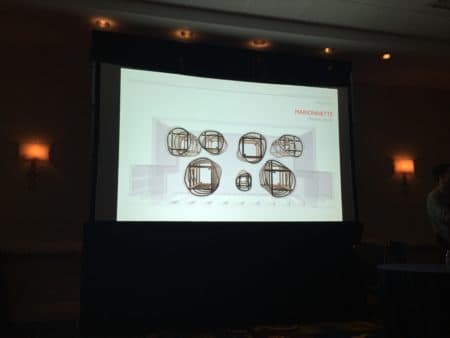
09 – An image from Jean Dières Monplaisir and Daniel Irvine’s session featuring Marionette workflows to generate these amazing forms, forms based on trees or forest mythology as part of a focused museum-exhibit space.
Baltimore city has a beautiful inner harbor, and the hotel faced west along this edge where a unique solar-powered floating contraception was anchored. The machine, complete with two mock eyeballs designed to give it a biomorphic character, skirts along the harbor scooping up trash and cleaning up the water. (see image 10)

10 – Baltimore’s inner harbor was never without delights. This solar-powered mechanical creature floats everywhere scooping up trash floating in the water.
Not all sessions had such large rooms or rooms with computers, but in several of the long sessions, participants gained hands-on experience learning new tools and features of the software. This 3D modeling session was very well attended. At one point during the session, attendees were shown how Vectorworks 2018 could easily model a very complex Richard Meier church project. Shown in a movie clip the modeling example demonstrated what is possible for architects using Vectorworks as a pure modeler. (see image 11).

11 – Hundreds of Vectorworks professionals come to the Design Summit to increase their skills and knowledge of the software. Computers were provided this year in rooms such as this one focused on 3D modeling.
The Vectorworks Design Summit typically ends with a customer appreciation party—complete with band and always dancing—but it’s a great moment to gain additional networking time and contact time with company executives.
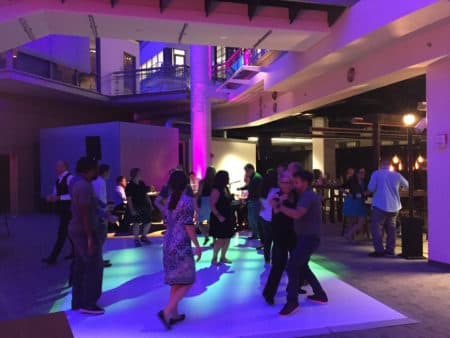
12 – It seems tradition now for the company to throw a good party at the Customer Appreciation Dinner held on the night before Day 1 and Day 2.
For learning more about the Vectorworks Design Summits, I encourage readers to visit this web page.
(disclosure: Vectorworks, Inc., paid for travel and hotel and all meals during this event. See our ethics policy page, link in the footer.)





Reader Comments
Comments for this story are closed